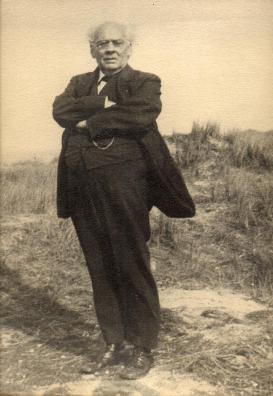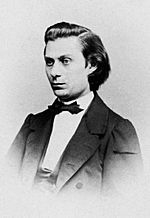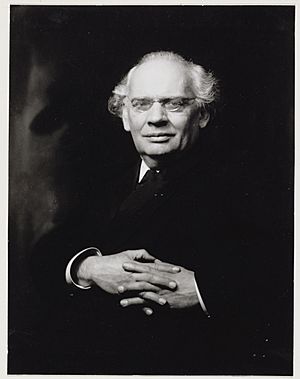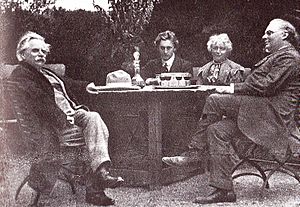Julius Röntgen facts for kids
Julius Engelbert Röntgen (born May 9, 1855 – died September 13, 1932) was a German-Dutch composer of classical music. He was a talented musician who became friends with famous composers like Franz Liszt, Johannes Brahms, and Edvard Grieg.
Contents
Early Life and Musical Beginnings
Julius Röntgen was born in Leipzig, Germany. His family was full of musicians. His father, Engelbert Röntgen, was a top violinist in the Gewandhaus orchestra in Leipzig. His mother, Pauline Klengel, was a skilled pianist.
Julius was a very gifted child. He and his sisters did not go to a regular school. Instead, his parents and grandparents taught him music. Other teachers helped him learn other subjects. His first piano teacher was Carl Reinecke, who led the Gewandhaus orchestra.
Julius's early music was inspired by Reinecke. He also learned from the styles of Robert Schumann, Franz Liszt, and Johannes Brahms.
When Julius was 14, in 1870, he visited Franz Liszt in Weimar. He played piano for Liszt and was even invited to a special party at Liszt's home.
In Leipzig, Julius and his parents were part of a music group. There, he first met the famous composer Brahms. Later, Röntgen moved to Munich. He studied piano with Franz Lachner, who was a friend of Franz Schubert. By the age of 18, Julius was a professional pianist.
During a concert tour, he met the singer Julius Stockhausen. He also met a Swedish music student named Amanda Maier. They later married in 1880.
Moving to Amsterdam
In 1877, Röntgen had to choose between living in Vienna or Amsterdam. He chose Amsterdam and became a piano teacher at a music school there. A friend of his father, Alexander de Savornin Lohman, helped him settle in. Lohman was a professor and important person in Amsterdam's cultural life.
Röntgen found the school had many students who were just learning. He felt it cared more about how many students it had than how good they were.
Between 1878 and 1885, Brahms often visited Amsterdam. In 1887, Röntgen played Brahms's second piano concerto. Brahms himself conducted the orchestra.
Röntgen helped create important music places in Amsterdam. In 1883, he helped start the Amsterdam Conservatory. He worked with other composers, Frans Coenen and Daniel de Lange. In 1884, Röntgen was very involved in starting the Concertgebouw, a famous concert hall.
He wanted to be the director of the Concertgebouw. But the job went to Hans von Bülow instead. The committee worried about Röntgen's conducting skills. However, Bülow could not take the job. So, the violinist Willem Kes became the director.
Composing and Performing
After this, Röntgen focused more on writing chamber music. He also put more energy into his work at the Conservatory. He became a well-known pianist who played with other musicians. He performed with the great violinist Carl Flesch. He also played with the singer Johannes Messchaert and the cello player Pablo Casals.
Röntgen traveled with Messchaert to Vienna at least once a year. There, he always met with Brahms.
During the quiet summer months in Amsterdam, Röntgen and his family often went to Denmark. On one trip, he met Bodil de Neergaard. They became close friends. From then on, he spent his summers at Neergaard’s home, Fuglsang, on the island of Lolland. He played concerts there every evening. Because of these visits, Röntgen's children learned to speak Danish very well. Some of Röntgen’s students included composers Anna Schytte and Hanna Vollenhoven.
For some years, Röntgen played music with his sons. His son Engelbert played the cello, and Julius Jr. played the violin. They performed together as a piano trio. After his first wife, Amanda, died in 1894, Röntgen married Abrahamina des Amorie van der Hoeven. She was also a talented piano teacher. The children from his second marriage also became professional musicians. His son Joachim, a violinist, started the Röntgen String Quartet.
Later Life and New Music
After World War I, in 1919, Röntgen became a citizen of the Netherlands. One of his sons was captured by the Germans during the war. Another son moved to the United States and joined the US army. Because of this, Röntgen could not visit his home country, Germany, for many years.
From 1920 onwards, Röntgen tried out new kinds of music. He experimented with atonal music, which doesn't follow traditional keys. For example, he wrote a bi-tonal symphony in 1930. Sometimes, he played piano for silent movies. He played popular and folk songs for films by Dirk van der Ven at the Tuschinski cinema in Amsterdam. He had already published these folk tunes earlier in his life. He also made many recordings for player pianos, also known as pianolas.
In 1924, Röntgen stopped performing in public. He moved to Bilthoven, a small village near Utrecht. His son Frants, who was an architect, designed a country house for him called Gaudeamus. The house had a special round music room. Its floor hung from the ceiling and did not touch the ground.
During the last eight years of his life, Röntgen wrote about 100 new pieces of music. Most of these were chamber music and songs. Gaudeamus became a place where many important composers and musicians met. Pablo Casals and Percy Grainger were among the visitors. At this time, Röntgen studied music analysis. He was interested in the works of Hindemith, Stravinsky, Schönberg, and Willem Pijper.
In 1930, Röntgen received an honorary doctorate from the University of Edinburgh. His friend Donald Francis Tovey was a professor there. During this visit, Tovey performed a new symphony by Röntgen. Röntgen himself was the soloist in two of his piano concertos in the same concert. Two years after Röntgen's death, Tovey called him "one of the greatest masters of absolute music I have ever known." After World War II, the villa Gaudeamus became home to the Gaudeamus society. This group works to promote new Dutch music.
Röntgen died in a hospital in Utrecht, Netherlands, on September 14, 1932. His very last work was a piano quintet. It was his third piece for piano and strings, and he called it Sentendo nuova forza. He finished it on July 5 of that year.
Musical Works
Julius Röntgen wrote a lot of music. His works include 25 symphonies and many concertos. He wrote 7 piano concertos, 3 violin concertos, and 3 cello concertos, plus other concertos. He also created many chamber pieces, piano works, and songs. He even finished Edvard Grieg's String Quartet No. 2, which Grieg had left unfinished.
Röntgen also arranged traditional Dutch melodies. He turned them into hymn tunes for churches. One such hymn tune is called "In Babilone." You can find it in "The United Methodist Hymnal" as hymn number 325. His name is spelled Roentgen in that hymnal. The same tune is also in the "Celebrating Grace" hymnal as hymn numbers 502, 508, and 649.
See also
- Erna Spoorenberg





